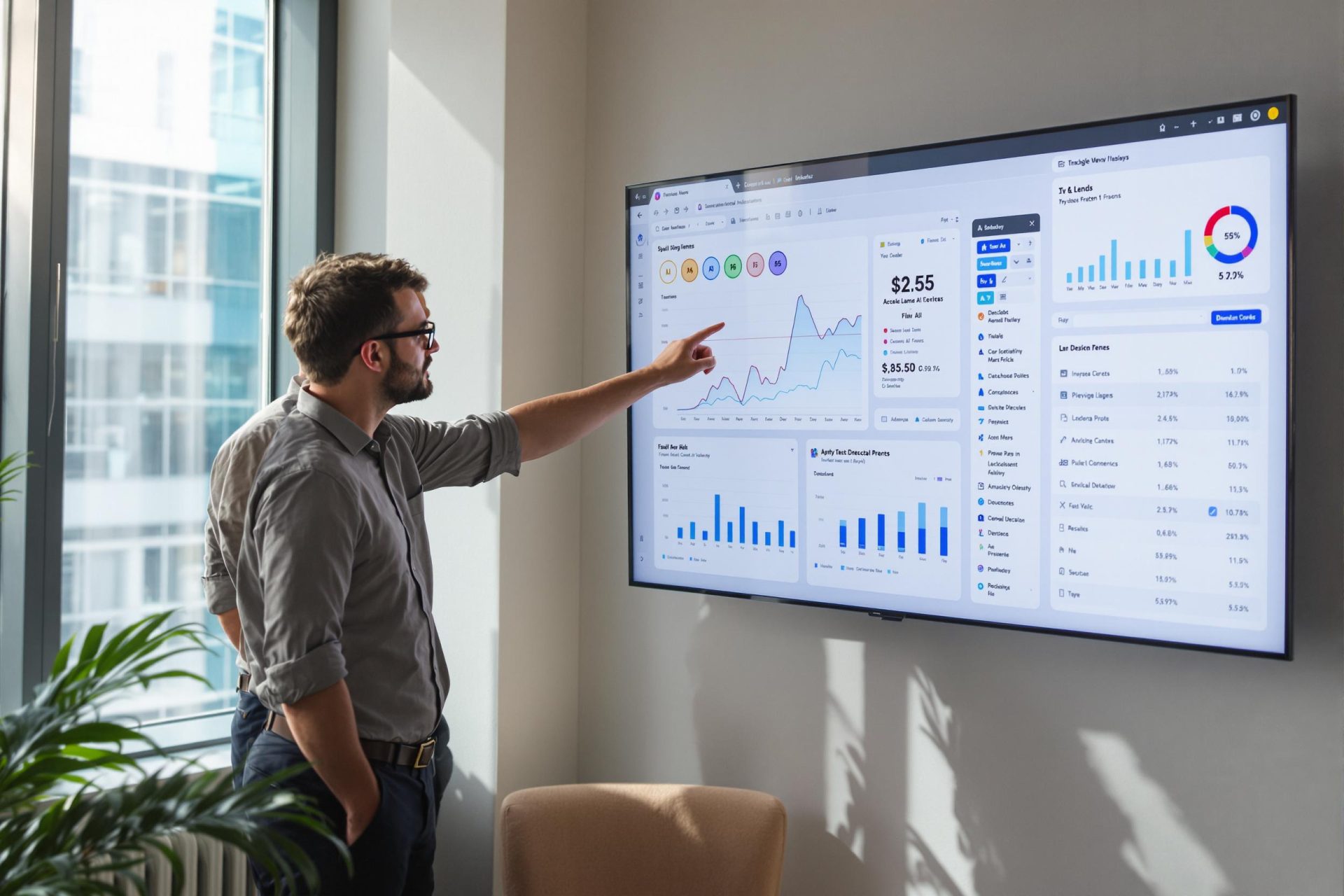Data analysis has never been easier. With AI-powered tools, analysts can now extract meaningful patterns and predictions from complex datasets without writing complex code or spending hours on manual processing.
⚙️ What they do: These AI tools automate data preparation, visualization, pattern recognition, and predictive modeling—turning raw numbers into actionable insights with minimal technical knowledge.
📊 Why use them: They dramatically reduce time-to-insight by handling repetitive tasks, suggesting optimal approaches, and uncovering hidden relationships that would be nearly impossible to find manually.
1. Alteryx – Data Preparation & Analytics Automation
What is it? Alteryx is a comprehensive platform built for analytical professionals that simplifies and accelerates data analytics. It features intuitive drag-and-drop functionality that democratizes complex data tasks, allowing users to build repeatable workflows without extensive coding.
Features:
- 🔄 Automated data preparation and transformation with connections to disparate data sources
- 📊 Both predictive and prescriptive analytics capabilities for forward-looking insights
- 🏢 Industry-specific analytical solutions for financial services, retail, manufacturing and insurance
Official site: Alteryx
2. Tableau – Visual Analytics & Natural Language
What is it? Tableau has evolved from a visualization-focused platform to incorporate advanced capabilities through “Tableau Next” and “Tableau Agent” features. These innovations enable users to generate insights, prepare data, and create visualizations through natural language interactions rather than manual configuration.
Features:
- 💬 Natural language interaction for data exploration and visualization creation
- 🤖 Automated analytics workflow acceleration with task automation and visualization recommendations
- 📈 Predictive analytics capabilities for forecasting trends and identifying opportunities
Official site: Tableau
3. Microsoft Power BI – Enterprise Data Visualization
What is it? Power BI combines robust data visualization capabilities with sophisticated features to streamline analytics workflows. The platform’s capabilities extend beyond basic visualization to include automated insight generation and advanced data preparation.
Features:
- 🗣️ Copilot integration for generating reports, DAX queries, and data summaries using conversational language
- 🔌 Connections to hundreds of data sources while maintaining governance and security
- 📱 Ability to embed reports and dashboards into other applications across organizational workflows
Official site: Microsoft Power BI
4. Databricks – Enterprise Data Intelligence Platform
What is it? Databricks unifies data, AI, and governance into a comprehensive Data Intelligence Platform designed for enterprise environments. The platform provides a collaborative workspace where data engineers, scientists, and business analysts can work together across the full data lifecycle.
Features:
- ⚡ Apache Spark foundation for processing massive datasets and supporting complex analytics
- 🏗️ Lakehouse architecture combining flexibility of data lakes with the structure of traditional warehouses
- 💬 Natural language querying for non-technical users alongside tools for building sophisticated ML models
Official site: Databricks
5. Julius AI – Conversational Data Analysis
What is it? Julius AI transforms data analysis through a conversational interface that enables professionals to interact with their data using natural language. Users can upload Excel files and other data formats, then analyze them by asking questions in plain English rather than writing complex formulas or code.
Features:
- 💬 Natural language interface for asking complex analytical questions without coding
- 📊 Automatic visualization generation and dataset manipulation through simple prompts
- 🔮 Predictive forecasting capabilities accessible through conversational requests
Official site: Julius AI
6. SAS Viya – End-to-End Analytics Platform
What is it? SAS Viya is an analytics platform designed to handle the full analytics lifecycle from data preparation through model deployment. The platform unifies various analytical approaches on a single, cloud-based architecture that scales to meet enterprise demands.
Features:
- 🧩 Comprehensive analytics framework incorporating statistical analysis, machine learning, and NLP
- 🚀 Automated data preparation and model building tools to accelerate time-to-insight
- 👥 Dual interfaces with visual tools for business users and programming options for data scientists
Official site: SAS Viya
7. Google Cloud AI Platform – Machine Learning Development
What is it? Vertex AI provides a unified environment for building and deploying machine learning models at scale. As Google’s flagship AI development platform, it offers access to pre-trained API models alongside tools for custom model development.
Features:
- 🔄 Seamless integration with Google’s data services and simplified MLOps for model lifecycle management
- 🧠 Access to advanced models like Gemini alongside AutoML capabilities for faster development
- 📹 Excellent handling of unstructured data like text, images, and video alongside traditional structured analysis
Official site: Google Cloud AI Platform
8. Rows – Spreadsheet-Based Analytics
What is it? Rows functions as an analytics platform that connects directly to various data sources. This tool bridges the gap between familiar spreadsheet interfaces and more sophisticated data analysis needs without requiring programming skills.
Features:
- 🔌 Direct connections to external APIs and services, pulling live data without complex integrations
- 🧮 Assistance with data transformation, formula suggestions, and automated analysis
- 👥 Collaborative sharing features that maintain live connections to data sources for team analysis
Official site: Rows
9. Domo – Business Intelligence Platform
What is it? Domo combines data integration, visualization, and analytics in a comprehensive business intelligence platform. The solution emphasizes accessibility for business users while providing the depth needed by data professionals.
Features:
- 💬 Conversational analytics for exploring data through natural language queries
- 🔍 Automated insights that highlight significant trends or anomalies in datasets
- 🤖 Customizable agents that address specific business questions and automate routine analysis
Official site: Domo
10. Sisense AI – Embedded Analytics
What is it? Sisense delivers embedded analytics capabilities throughout the analytical workflow. The platform focuses on making complex data accessible through intuitive interfaces and automated processes.
Features:
- 💬 Conversational analytics for data modeling, exploration, and understanding
- 🧩 Strong capabilities for handling disparate data sources and complex data models
- 🔌 Embedded approach for integrating analytics directly into existing applications and workflows
Official site: Sisense AI
11. H2O.ai – Automated Machine Learning
What is it? H2O.ai provides a comprehensive set of tools for both predictive and generative applications in data analysis. The platform includes Driverless AI for automated machine learning and newer tools like h2oGPTe for enterprise language models.
Features:
- 🔍 Automated machine learning with transparency about how predictions are generated
- 🛡️ Applications ranging from fraud detection to customer analytics across multiple industries
- ⚙️ Flexibility for data scientists to customize models while automating repetitive development tasks
Official site: H2O.ai
12. KNIME – Visual Workflow Analytics
What is it? KNIME provides a visual workflow approach to data science and analytics that makes complex processes more accessible. The platform connects nodes representing different data operations into complete analytical workflows without requiring extensive coding.
Features:
- 🧩 Node-based architecture that integrates various analytical methods including deep learning
- 👥 Collaborative environment that enables both data experts and domain specialists to work together
- 🌐 Open-source foundation with thousands of pre-built components created by the community
Official site: KNIME
13. RapidMiner – Data Science & ML Platform
What is it? RapidMiner, now part of Altair, provides a comprehensive environment for data preparation, machine learning, and model deployment. The platform balances accessibility for business users with the depth required by data scientists.
Features:
- 🔄 End-to-end capabilities from automated data extraction to predictive modeling
- 🤖 AI agents that accelerate analytical workflows and provide guidance for complex analyses
- 📋 Templates and workflows for industry-specific applications and common analytical challenges
Official site: RapidMiner
14. Polymer Search – Data Experience Platform
What is it? Polymer Search specializes in embedded analytics that transform raw data into interactive visualization experiences. The platform enables organizations to integrate sophisticated analytics directly into their products and applications.
Features:
- 📊 Automated data storytelling that generates visualizations highlighting key insights
- 🔍 Self-service features and intuitive interfaces making complex data accessible to end-users
- 🔌 Framework for developers to enhance products with analytical capabilities and engaging experiences
Official site: Polymer Search
15. Deep Research (OpenAI) – Advanced Research Analysis
What is it? Deep Research represents OpenAI’s specialized approach to complex data analysis and research. While details in public materials are limited, the tool has demonstrated significant capability in understanding industry trends and enhancing research capacity.
Features:
- 📚 Analysis of large datasets and complex information to derive meaningful insights
- 🔍 Processing of diverse information sources to identify difficult-to-detect patterns
- 🧠 Augmentation of human analytical capabilities with pattern recognition and synthesis
Official site: Deep Research (OpenAI)
16. Clay – Go-to-Market Intelligence
What is it? Clay focuses on go-to-market intelligence, using technology to transform raw data into actionable insights for sales, marketing, and operations teams. The platform automates research processes that would typically require significant manual effort.
Features:
- 🧹 Automated data cleaning, formatting, and generation of unique data points
- 🔄 Consolidation of information from over 100 providers for comprehensive market views
- 📋 Structured workflows converting information into actionable outcomes like personalized outreach
Official site: Clay
17. Apache Spark – Big Data Processing
What is it? Apache Spark provides the computational foundation for large-scale data analytics and machine learning applications. While not exclusively an AI tool, Spark enables the data processing capabilities that underpin sophisticated analytical applications.
Features:
- ⚡ Distributed computing for processing datasets too large for traditional analytical tools
- 📚 MLlib machine learning library supporting common algorithms and workflows
- 🚀 Performance and scalability for training models on massive datasets efficiently
Official site: Apache Spark
18. Google Cloud AutoML – Accessible Machine Learning
What is it? Google Cloud AutoML democratizes machine learning by enabling professionals to build custom models with minimal ML expertise. The platform automates many technical aspects of model development while maintaining the flexibility to address specific business problems.
Features:
- ⚙️ Automated feature engineering, model selection, and hyperparameter tuning
- 📊 Support for various data types including tabular data, images, and text
- 🌉 Bridge to sophisticated predictive capabilities for organizations with limited ML resources
Official site: Google Cloud AutoML
19. IBM Watson Analytics – Enterprise AI Platform
What is it? IBM’s Watson has evolved into watsonx, a comprehensive AI platform that includes specialized tools for data-intensive applications. The watsonx portfolio encompasses watsonx.ai for model development and watsonx.data for managing AI workloads across diverse data types.
Features:
- 🧠 Foundation models that can be adapted for specific domains and use cases
- 🛠️ Tools for training, validating, tuning, and deploying models with governance
- 🏢 Structured approach to implementing AI across multiple business functions
Official site: IBM Watson Analytics
20. Microsoft Excel – Augmented Spreadsheet Analysis
What is it? Excel has transformed from a traditional spreadsheet application into a tool with significant capabilities through the integration of Microsoft Copilot. This evolution makes advanced analytics more accessible to professionals who are already familiar with Excel’s interface.
Features:
- 💬 Copilot assistance with formulas, formatting, and insight generation through natural language
- 🔍 Automatic identification of trends and outliers within spreadsheet data
- ⚙️ Automation of repetitive tasks and suggested analytical approaches based on data characteristics
Official site: Microsoft Excel



